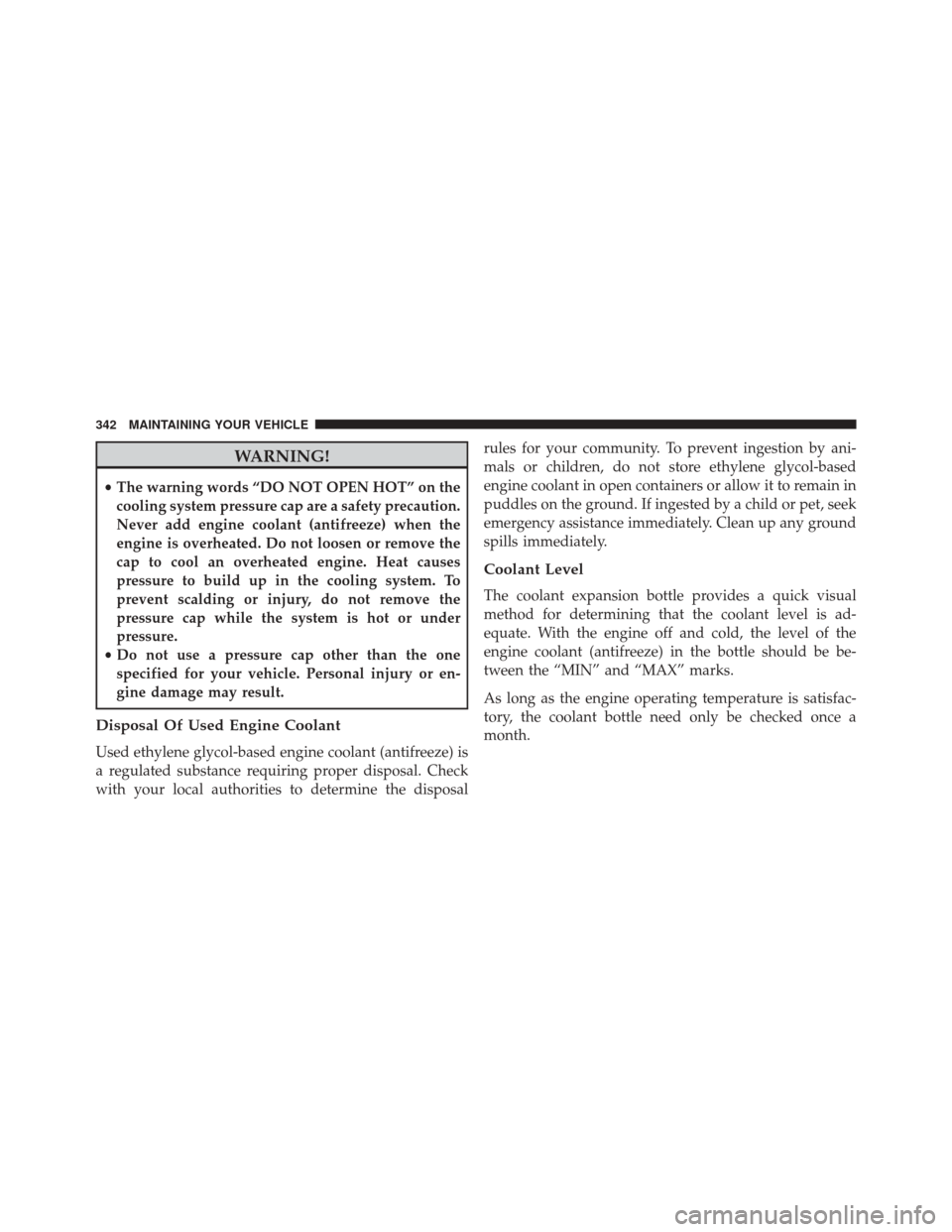Page 339 of 409

Under normal operating conditions, the catalytic con-
verter will not require maintenance. However, it is im-
portant to keep the engine properly tuned to assure
proper catalyst operation and prevent possible catalyst
damage.
NOTE:Intentional tampering with emissions control
systems can result in civil penalties being assessed
against you.
In unusual situations involving grossly malfunctioning
engine operation, a scorching odor may suggest severe
and abnormal catalyst overheating. If this occurs, stop
the vehicle, turn off the engine and allow it to cool.
Service, including a tune-up to manufacturer’s specifica-
tions, should be obtained immediately. To minimize the possibility of catalytic converter dam-
age:
•
Do not shut off the engine or interrupt the ignition,
when the transmission is in gear and the vehicle is in
motion.
• Do not try to start the engine by pushing or towing the
vehicle.
• Do not idle the engine with any spark plug wires
disconnected or removed, such as when diagnostic
testing, or for prolonged periods during very rough
idle or malfunctioning operating conditions.
7
MAINTAINING YOUR VEHICLE 337
Page 344 of 409

WARNING!
•The warning words “DO NOT OPEN HOT” on the
cooling system pressure cap are a safety precaution.
Never add engine coolant (antifreeze) when the
engine is overheated. Do not loosen or remove the
cap to cool an overheated engine. Heat causes
pressure to build up in the cooling system. To
prevent scalding or injury, do not remove the
pressure cap while the system is hot or under
pressure.
• Do not use a pressure cap other than the one
specified for your vehicle. Personal injury or en-
gine damage may result.
Disposal Of Used Engine Coolant
Used ethylene glycol-based engine coolant (antifreeze) is
a regulated substance requiring proper disposal. Check
with your local authorities to determine the disposal rules for your community. To prevent ingestion by ani-
mals or children, do not store ethylene glycol-based
engine coolant in open containers or allow it to remain in
puddles on the ground. If ingested by a child or pet, seek
emergency assistance immediately. Clean up any ground
spills immediately.
Coolant Level
The coolant expansion bottle provides a quick visual
method for determining that the coolant level is ad-
equate. With the engine off and cold, the level of the
engine coolant (antifreeze) in the bottle should be be-
tween the “MIN” and “MAX” marks.
As long as the engine operating temperature is satisfac-
tory, the coolant bottle need only be checked once a
month.
342 MAINTAINING YOUR VEHICLE
Page 397 of 409

DrivingThrough Flowing, Rising, or Shallow Standing
Water ............................... .232
Electrical Outlet, Auxiliary (Power Outlet) ........144
Electrical Power Outlets .....................144
Electric Remote Mirrors ......................92
Electronic Brake Control System ...............239
Brake Assist System .....................239
Electronic Roll Mitigation (ERM) ..............246
Electronic Speed Control (Cruise Control) ........121
Electronic Stability Control (ESC) ..............242
Electronic Vehicle Information Center (EVIC) ......131
Exit Trip ............................. .173
Start Of Trip Procedure ...................173
Emergency Deck Lid Release ..................29
Emergency, In Case of Hazard Warning Flasher ..................287
Jacking .............................. .301Jump Starting
......................... .308
Towing ............................. .316
Emergency Trunk Release ....................29
Engine Air Cleaner .......................... .326
Break-In Recommendations .................80
Checking Oil Level ..................... .324
Compartment ......................... .321
Cooling ............................. .338
Exhaust Gas Caution .....................82
Fails to Start .......................... .213
Flooded, Starting ...................... .213
Fuel Requirements ..................... .277
Oil................................. .324
Oil Filler Cap ......................... .325
Oil Selection .......................... .325
Overheating .......................... .287
Starting ..............................211
Temperature Gauge ..................... .159
10
INDEX 395
Page 402 of 409

Rearview..............................90
Modifications/Alterations, Vehicle ...............8
Monitor, Tire Pressure System ................271
Multi-Function Control Lever .................110
New Vehicle Break-In Period ..................80
Occupant Restraints ........................49
Occupant Restraints (Sedan) ..................30
Octane Rating, Gasoline (Fuel) ................277
Odometer .............................. .166
Trip ................................ .166
Oil Change Indicator ...................... .171
Oil Change Indicator, Reset ..................171
Oil, Engine ............................. .324
Capacity ............................ .369
Change Interval ....................... .325
Checking ............................ .324
Disposal ............................. .326Filter
............................... .326
Filter Disposal ........................ .326
Materials Added to ..................... .326
Recommendation ...................... .325
Viscosity ............................ .325
Oil Filter, Selection ....................... .326
Onboard Diagnostic System ..................322
Opener, Garage Door (HomeLink®) ............133
Operating Precautions ..................... .322
Operator Manual (Owner’s Manual) .............5
Overheating, Engine ...................... .160
Owner’s Manual (Operator Manual) .............5
Paint Care ............................. .349
Parking Brake ........................... .235
ParkSense® System, Rear ....................125
Passing Light ............................111
Pets ....................................80
Placard, Tire and Loading Information ..........254
400 INDEX